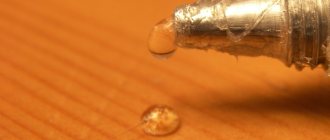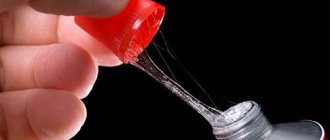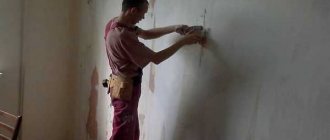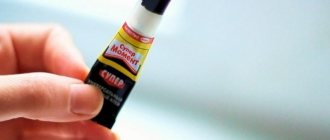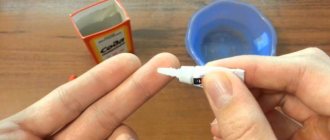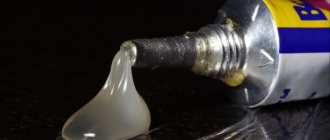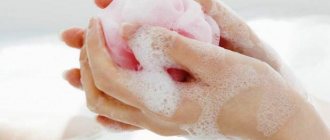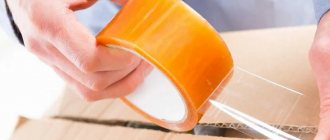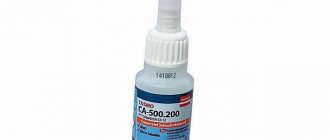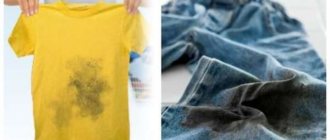Removing superglue from furniture must be done carefully. The difference between superglue is that it hardens instantly, so you work with it quickly and carefully. If the product gets on furniture, you must act quickly.
To remove fresh contaminants, no aggressive agents are required. It will be easier to keep the surface in its original condition. You can remove superglue from tables and other furniture using folk remedies or chemical compounds. Each product must be tested, since many methods cannot be used on wooden furniture, especially if it is not varnished or painted.
What ways can damage the table surface?
There are many ways to remove glue from a table, but mindlessly following useful tips often leads to damage to a piece of furniture. The following recommendations will help you avoid negative experiences:
- If you are unsure of the material's reaction to the solvent, do not use it.
- Do not use gasoline, ethyl alcohol, white spirit, acetone, or other caustic solvents indoors, in the presence of children. They can cause poisoning due to toxic fumes.
- Do not use chemicals to remove glue that has spilled onto dishes or other items in which food is stored.
- Use gentle methods to combat stubborn stains first, then move on to aggressive ones.
- Always test the composition before applying it to visible areas of the product and large areas. Observe the reaction for a few minutes. Be sure to rinse and wipe the area of application to study the effect.
When cleaning a table or other surfaces, wear rubber or vinyl gloves to prevent irritation and other skin reactions.
This is an important condition for the safe use of caustic compounds.
If there is a tendency to allergic reactions, diseases of the respiratory system, bronchi, wear a respirator. Toxic substances in solvents can cause nausea, headaches, and affect the functioning of internal organs. Don't forget to ventilate the room while working.
Superglue is an achievement of the modern world. It is in every home. Use this powerful product carefully. Protect the table or other surface where you will glue with newspaper, oilcloth, or a board. Drops dry quickly and are difficult to remove. It won't be easy to remove super glue from chairs, tables, and other furniture. Cleaning requires the use of special compounds that can harm furniture
Be careful and take precautions
The article has been verified by the editors
How to remove superglue from tables and other furniture?
It is important to be careful when working with superglue and never leave the tube uncovered. If there are already traces of glue on the table, you need to act as quickly as possible
After all, when fresh contamination is removed, there is a much greater chance of maintaining the integrity of the coating. You can clean it using both improvised means and special solvents.
Many products cannot be used to remove glue from a wooden table, especially if the material is not coated with paint or varnish.
Folk remedies
When choosing a cleaning composition, you should consider what material the table is made of. In most cases it is wood or plastic covering MDF or chipboard.
It is much easier to remove superglue from a plastic coating at home than from a wooden one, since this material is resistant to water and can withstand mechanical cleaning. The only thing is that you should not use too aggressive chemicals that can corrode it. Proven folk recipes will come to the rescue.
Water
If the glue stain has dried out a little, you need to soften it before mechanical cleaning. This can be done using ordinary water. You will need:
- moisten a cloth with warm water;
- place it on the contaminated area without squeezing it;
- Leave for a day, re-wetting the cloth as it dries.
After some time, the glue will soften and it can be removed mechanically without harm to the surface.
Vegetable oil
Another proven remedy that will help soften superglue is sunflower oil.
Algorithm of actions:
- slightly heat the vegetable oil;
- moisten a rag with it generously and place it on the stain;
- leave for several hours and remove any remaining adhesive using mechanical force.
The oil can be used to clean plastic, glass, metal or varnished wood. After this procedure, greasy marks will remain on untreated wooden surfaces.
Alcohol
If, after removing the bulk of the sticky composition, traces of glue remain on the table, you can treat them with medical alcohol. You will need to wet a rag with it and rub the stains well.
It is strictly not recommended to use alcohol to clean painted surfaces. As a result of such actions, untidy stains will remain on the coating.
Heating
The heat treatment method is also suitable for cleaning plastic.
Procedure steps:
- turn on the hairdryer and direct hot air onto the stuck superglue;
- in this case, it is necessary to maintain a distance of 20 cm, otherwise the coating will overheat and deform;
- After the mass melts, it is removed with a napkin.
High temperatures must be used very carefully. If the wooden table is covered with paint, it is better to choose another cleaning method
The paint may swell and crack during the procedure.
Solvents
If folk remedies turned out to be ineffective and could not soften the superglue, you will have to use chemical solvents.
This must be done carefully so as not to damage the skin of your hands and the surface being cleaned.
White Spirit
This substance is applied to a rag and traces of glue are wiped off. When the composition softens, it can be removed mechanically.
After cleaning, wipe the table with a clean damp cloth.
Refined gasoline
Remains of sticky mass can be removed using this product. You will need:
- moisten a rag with it and wipe the contaminated areas until the surface is completely clean;
- Afterwards, you can wash off traces of gasoline with a sponge soaked in lemon juice.
Do not use gasoline to clean unvarnished wood, as greasy stains will remain on it.
Acetone
Acetone or nail polish remover will help remove dried glue. The latter acts softer, but may not cope with traces of second glue. Before starting the procedure, it is worth checking the effect of the solvent on an inconspicuous area of the table.
Procedure:
- Pour acetone over the stained area and wait 30–40 minutes;
- After the allotted time has passed, it is necessary to remove the remaining sticky mass.
After this, you will have to remove the smell of acetone by soaking an old toothbrush in a soapy solution and wiping the cleaned surface.
Mechanical cleaning
After the glue has been softened by the above means, it is necessary to clean it from the surface. To do this, you will need to carry out mechanical cleaning by performing a series of sequential steps:
- take a sharp knife or thin blade;
- cut off the top layer of the sticky mass, holding the knife parallel to the table;
- clean off glue residues using folk remedies or solvents;
- Finally, wipe the cleaned areas with a clean damp cloth.
How to clean depending on the type of surface?
How to quickly get rid of stains on a metal surface?
To clean a metal surface from glue stains, it is recommended to use acetone or another solvent. Step-by-step instruction:
- Soak a cotton cloth or cotton pad with acetone. Leave the dampened cloth on the contaminated surface until the glue is completely dissolved.
- Remaining glue will most likely have to be scraped off with a knife or other sharp object.
REFERENCE! Instead of acetone, you can use denatured alcohol or lighter fluid. The algorithm for using the products is the same as in the case of acetone. Hydrogen peroxide also works well.
Tips for cleaning metal:
- test the cleaning solution on a small area of the surface to see how the material reacts to the cleaning agent;
- Stainless steel is easily scratched when using even slightly abrasive sponges.
Tree
Experienced housewives claim that it is better to use a special Anti-Glue product for wooden surfaces. The best way to remove stains from untreated wood is mechanically - scraping followed by sanding.
If there is still a final stage of processing the wood and there is glue on it, it is allowed to use a solvent. Dimexide and acetone will help remove the surface layer of glue, and remove its remains with a sharp object.
For treated wood, soap solution, acetone and ethanol are more suitable.
Plastic
It is allowed to use dimexide, but only for rubbing, not soaking the material. If soaked, the plastic may break down.
You should be careful with acetone, as it can change the color of the plastic - it is better not to leave the liquid on the surface for a long time. It is better to test the effect of acetone on a small area of the surface.
Important! The most gentle way is to use ethanol, but it is recommended to use it as soon as possible.
Stains aren't just left on tables. You can find out how to clean a mattress from stains here, and a carpet here. Find out also how to dry a sofa from water, beer, and urine stains.
How to remove Moment glue from your hands and remove superdrops from your skin
If the above measures are ignored, then be prepared for cleaning. First of all, you will have to save your nails from glue. What to use?
Special “Anti-glue”
Peculiarities. Hardware and construction stores sell special glue removers. Often. The cost of a 5 g tube varies from 30 to 40 rubles (data as of August 2022). The product allows you to quickly clean off dirt and does not cause an allergic reaction.
What we do
- Take Anti-Glue and apply it to the area contaminated with glue.
- We wait one hour (the time is indicated in the manufacturer’s instructions).
- Remove the residues in warm water with soap and powder.
You can use “Anti-glue Super Moment” from the German manufacturer Henkel, the Chinese “Strength”, and the Swiss “Second”. If you clean the glue from your fingers, you do not need to keep the composition on for an hour. In this case, you can remove superglue from your hands faster if you additionally use a non-rigid sponge.
Gentle solvent
Peculiarities. Less safe, but you can quickly wash superglue from your fingers by using solvents. In particular, those containing acetone (nail polish remover). Gasoline (“Galosh”) or white spirit should not be used. These are products for furniture and clothing, but not for the body.
What we do
- Take a cotton pad and soak it in nail polish remover.
- We wipe off superdrops.
- Rinse the skin with warm soapy water.
If the skin is delicate, damaged by scratches and cracks, then this method should absolutely not be used. It is better to replace the solvent with ammonia. The procedure with it consists of the same actions.
"Dimexide"
Peculiarities. "Dimexide" can be purchased at the pharmacy. The product is not only effective, but also budget-friendly. The drug is useful in the household not only for the war with glue - it is an antiseptic, which can also be used in facial and hair care.
What we do
- Soak a cotton pad in antiseptic.
- Leave on contaminated areas for several minutes.
- We wash the treated areas with warm water.
Soap solution and salt
Peculiarities. One of the most effective and simplest ways to get rid of Moment stains is salt or soap solutions. The process is not quick, so you need to be patient.
What we do
- Soak pieces of soap in warm water or dissolve table salt (three tablespoons per glass of water).
- Soak your hands in the bath for 10-15 minutes.
- Rinse with water.
For greater anti-glue effect, use a sponge or washcloth. You can also add a little vinegar to the bath, but only if there are no irritations or wounds on the skin.
Edible oils
Peculiarities. The question of how to remove superglue from the skin of your hands can be resolved with the help of these food products. This is a budget and the simplest solution to the problem. It is also absolutely safe for the skin.
What we do
- Thickly lubricate the areas contaminated with glue with butter or vegetable oil.
- Leave for five to seven minutes.
- Rinse your hands in a soap bath.
Cosmetic creams work on the same principle against glue.
But it is important that it has a fatty, thick consistency. Suitable, for example, for children.
Mechanical stripping
Peculiarities. The hard way
It is recommended to be careful not to harm the skin. Use pumice, nail file, sandpaper
Great if there are several layers of glue left on the surface of your hands.
What we do
- Take sandpaper, a file or pumice.
- Carefully clean off the dried glue stain.
- Wash off any remaining residue in warm soapy water.
It is better to choose “zero” sandpaper, and the nail file should be of medium hardness. This will protect your skin from damage. It is strictly forbidden to tear fingers glued together with glue from each other with sudden movements.
Important Tips
In order not to aggravate the situation and not complicate your work, remember a few simple tips:
- Do not wipe off drops of fresh composition with a rag or napkin. You will stretch the second glue over the surface and instead of a small drop you will have a large dirty area that is much more difficult to wipe off. Take a toothpick, a piece of construction paper, or something else and carefully pry the droplet to remove it with minimal damage.
- Do not try to remove the glue with your fingers. Anyone who has had similar compounds come into contact with their skin knows how unpleasant it is and how long it takes to scrub their fingers off afterwards. Always use a tissue or something else to remove dirt without getting dirty.
Everything sticks to glue-stained fingers
- The sooner you start work, the better. No need to wait for the surface to dry. When the mass polymerizes, it becomes tens of times stronger and harder. But fresh stains can be removed much easier and faster, and you are almost guaranteed to remove the glue without a trace, which is not always possible if it has dried out and become embedded in the surface.
- It is better to prevent a problem than to fight it. Before starting work, I advise you to cover the tabletop with a rag or newspaper, so that even if the glue spills, you can easily clean it up. You can lay a sheet of paper only on part of the table, this is usually quite enough to glue something together.
Cover the table with paper, and if you spill the composition on the surface, cleaning it up will be as easy as pie
Try different means. The effectiveness of one or another option depends on a number of circumstances. Therefore, I advise you to start with the simplest solutions that are at hand. And if they do not give the desired effect, then use more potent formulations. Always be careful while working
You need to be very careful when cleaning a varnished table, as the coating is easily damaged. To avoid polishing the surface later and re-painting it, do not rub too hard. Try chemicals on an inconspicuous area
To make sure that the product you choose does not damage the surface or leave marks on it, drop it on an inconspicuous area and wait a few minutes. If nothing happens, you can use this composition.
Methods for removing superglue
Since the use of instant glue often leaves dirt on the skin, craftsmen have come up with a large number of ways to get rid of the glue. Moreover, manufacturers took the initiative and developed a special composition that effectively removes dried pieces of adhesive. As a result, all methods can be divided into two types: special plus household chemicals and folk ones.
Special products and chemicals
In hardware and construction stores you can buy a special solvent for superglue (“anti-glue”)
. They quickly remove traces of glue from any surface; you just need to apply a little product to the stain and leave it for an hour, and then wash off with soapy water. If you remove superglue from your hands, it is better to deviate from the instructions and reduce the time the substance remains on the skin in order to damage the epidermis.
The most popular compositions: German “Anti-glue Super Moment”
from Henkel, the Swiss
“Secunda Antikley”
and the Chinese glue remover
“Strength”
from the Contact company. The compositions are packaged in small 3-5 gram tubes, which cost around 70 rubles.
You can also buy the antiseptic and anti-inflammatory drug Dimexide
, which in practice also removes such contaminants well. It is necessary to wipe the stained skin with a cotton pad soaked in the product. Repeat the procedure until completely cleansed.
You can remove instant glue from skin and nails using various solvents.
: Acetone or nail polish remover is usually used, but gasoline and
WhiteSpirit
will also do the job.
Sometimes acetone is also combined with WD-40
. These substances will help peel off particles of the moment, which then just need to be washed off with water. If the stain is not completely removed, repeat the procedure.
Most of the products mentioned have a strong, unpleasant odor, so it makes sense to carry out the procedure in a ventilated area, away from children. Also, avoid getting products into your eyes.
Folk remedies
If you don’t have a special product on hand or for some reason you don’t want to deal with chemistry, there are a large number of folk remedies to clean your hands of the glue of the moment.
Mechanical methods:
You can remove the glue by scraping using various abrasive materials - sandpaper (sandpaper), a manicure file or pumice.
This must be done carefully so as not to harm the skin.
Various substances and cosmetic products with abrasive properties are also suitable: scrubs, granulated sugar, rock salt. After use, wash off any remaining adhesive with soapy water.
Granulated sugar is also used to make a paste with the addition of lemon juice, since citric acid promotes the exfoliation of dead epidermal cells.
By softening:
- Rub a small amount of Vaseline, lotion
or
vegetable oil
into the affected areas of the skin, allow the scabs to soften, and then remove. - If the dirt is minor, you can try cleaning them with warm water and soap
. - Bath with the addition of soap shavings and baking soda.
Soak your hands in the hot bath for 15 minutes and then remove the glue with a scrub or pumice stone.
Other methods:
Using table salt. You need to first steam your hands, and then pour a small amount of salt onto the dried glue. Rub in for a few minutes until the salt turns into a white foam, then rinse off.
Ways to remove drops from objects
The time that has passed since the paint hit the object is of primary importance in choosing a method for eliminating drops and stains. Possible removal methods may vary depending on the time elapsed.
Immediately after the stain appears
For fresh paint, all you need is warm water, soap and a sponge. Use a few smooth movements without applying too much pressure to remove the stain. Wipe the area to be treated with a sponge soaked in soapy water. After this, rinse with clean water. Drops from clothing are removed in the same way.
After finishing work, immerse the brushes in a container with warm water. Leave for 15-20 minutes. After the time has passed, rinse under running water.
The time it takes for the stain to appear is several hours (up to a day)
It is necessary to use any degreaser that is available in the house. This could be dish soap, vodka, alcohol or solvent. It is possible to use vinegar. To soften the paint, moisten the stain with the available product several times.
Removing dirt from clothing is done in the same way. The quality of the fabric should be taken into account. The use of, for example, solvent is not recommended for some materials from which clothing is made.
Several days or more have passed
In this case, more potent agents are used:
- petrol;
- White Spirit;
- acetone;
- kerosene;
- brake fluid.
You can use nail polish remover. To protect your hands from exposure to such aggressive substances, it is necessary to use rubber gloves. Any of the selected products is applied to the surface requiring cleaning using a sponge.
The film former of acrylic paint softens within 30 minutes.
During this time, it is necessary to repeat the wetting procedure two or three times. Softened paint can be removed with a cloth soaked in the substance used. The cloth is used as a more durable base than the sponge.
Neutralization with alcohol
Add a teaspoon of solvent to a tablespoon of toothpaste and stir thoroughly;
- Apply the prepared mixture to the stain and leave for 15 minutes.
- Using a soft toothbrush, we try to wipe away traces of glue; to do this, rub the dried mixture in a circular motion.
- Use a plastic spatula to remove any remaining dirt, then wipe the surface with warm soapy water.
Acetone is often used to remove glue from the surface of a plastic table. The surface cleaning process is as follows:
- the solution is applied to a piece of cotton wool and rubbed over the area where the adhesive “plaque” has formed (when removed with acetone, the stain should dry completely);
- the product makes the stain soft and its adhesion to the damaged part of the countertop is reduced;
- then take a cloth and wipe the damaged area.
Everything has been removed, but the smell and traces of acetone remain. To remove them, use soap diluted in water. The solution is applied to an old toothbrush and the acetone remaining on the surface of the plastic is removed.
Also, super glue is removed from the table surface using varnish. The principle of operation is the same as when removing with acetone, except that the varnish must be applied to the area to be wiped several times to soften the glue.
Super glue can still be removed from glass and plastic tables using an alcohol solution purchased at a pharmacy. The process of removing dried stains using this method consists of the following steps:
- Apply alcohol to the place where the stain has formed;
- now you need to wait five minutes;
- wipe the solution with a clean, soft cloth;
- The wiped area is treated with warm liquid.
Although plastic may lose its color when treated with acetone, this is not as noticeable as if it is poured onto a wood surface.
If a lot of super glue has been spilled on the surface of a wooden table and cannot be removed by other methods, and there is not enough money to buy expensive household chemicals, there is a completely professional method - removing glue from wood by applying varnish.
To remove super glue from the surface of a wooden table in this way, you must perform the following steps:
- take sandpaper and carefully clean the damaged area;
- It is best to seal the area around with tape;
- if scratches occur, the area should be moistened with water;
- when the liquid dries, treat with fine-grained sandpaper;
- then the surface is primed with wax for the final removal of small cracks and better adhesion of the part of the object being repaired to the varnish;
- after complete drying, the whole thing is sanded again with fine “sandpaper” and wiped with a rag;
- then take a brush with a bristle attachment and apply the varnish in several layers with smooth movements;
- You must first select a dye of a similar color.
Removing glue from the skin of the eyes or lips
The hardest thing to wash off is superglue from your eyes or lips. The skin here is very delicate and the use of solvents or abrasives is impossible. Therefore, only the most gentle method of removing glue is possible.
For safety reasons, you should not open a tube of glue with your teeth. But sometimes, due to inattention or carelessness, a person can break this rule. And then there is a high probability that the glue will get on the lips and stick them together.
The only way to remove glue from the surface of your lips is:
- After pouring enough warm water into a bowl, soak your lips in the liquid for a few minutes. If possible, make small movements with your lips.
- After collecting more saliva in your mouth, push it through your lips. This way, your lips will be moisturized on both sides.
- Carefully remove the glue.
You can remove superglue from your eyelids using a piece of cloth soaked in warm water. The fabric will have to be applied many times in order for the glue to soften.
Adviсe
Recommendations for removing superglue from the table:
When working with solvents, you need to take care of your own safety. Protect your hands with gloves, and your mouth and nose with a respirator.- After completing the treatment, wipe the table with a clean, damp cloth to remove any remaining solvent and glue.
- The solvent can only be applied to light-colored fabric. If you use colored napkins, they will fade and the pigment will become embedded in the surface being treated.
- Solvents should not be left on the table. It is better to wash off the composition with water and repeat the procedure again.
You will find a lot of useful information about removing glue here.
Features of removing super glue
For the ability to quickly dry super glue, the Moment is usually called a second. Its hardening during the gluing process occurs on average in 60 seconds. Upon contact with water, Moment glue becomes hard almost instantly. It is capable of firmly bonding parts even when applied in a thin layer. In addition, some variations of Moment super glue are heat-resistant. Since the consumption of the product is very low, it is produced in small tubes. One drop of super glue can cover up to 2.5 cm of area.
There are several types of super glue. Each of them requires a specific approach. How to wipe off Secunda glue also depends on what material it came into contact with. This is because some products used to dissolve glue can damage the parts being glued. When working with Moment super glue, safety precautions should be observed. The use of wool and cotton materials is strictly prohibited. If they come into contact with cyanoacrylates contained in the second glue, you can get burned.
High-quality super glue is resistant to moisture and high temperatures. It can only be removed by a professional product that can be purchased at a hardware store. Their main disadvantage is the chemicals in their composition that have a high level of toxicity.
Attention! Most often, one-component super glue is found on sale, but multi-component ones are also available. In the second case, in addition to cyanoacrylate binders, it contains fillers that conduct heat and electric current.
What is all the repairs based on? Removing glue and tape
After the renovation, the room is pleasing to the eye. New wallpaper. Shining double-glazed windows. Laminate laid in even rows... But as soon as you come closer and take a closer look, unpleasant to the eye stains from adhesive tape on the plastic, drops of glue, and traces of double-sided tape immediately appear. The tape itself has long been removed, but the dirt remains.
Method 1
If the surface is difficult to damage or scratch, you can cut off the remaining dried glue with a stationery knife or rub it with a metal sponge.
Method 2
Method 3
Unpainted surfaces can be easily cleaned with acetone or white spirit. For example, in this way it is most often possible to rid glass (windows) of glue.
Method 4
Soda paste can be used to clean various surfaces, even upholstered furniture. You need to prepare a mixture of baking soda and water and apply it to the adhesive stain. Leave for 15 – 20 minutes. If you are concerned about the material deteriorating, try applying the prepared paste to a less visible area first. Residues are removed with warm water.
Method 5
Method 6
Use the product in aerosol format. For example, PROSEPT Duty Universal will help remove dried glue, traces of tape and stickers from almost any surface. The composition based on organic solvents perfectly dissolves the adhesive base, but does not damage the surface of the material. On the contrary, white plastic will shine in a new way due to the whitening effect.
Method 7
If you are wondering how to remove a sticker or thick tape from surfaces that you do not want to get wet, a plastic spatula or scraper will come to the rescue. Gently pry up one edge and peel off the film.
Helpful information
In order to clean furniture from glue efficiently and without consequences, you need to take into account the following tips:
Softened glue is removed only with plastic or wooden means. Metal objects are not suitable for this, as they leave behind scratches.- Gloves are used to protect the skin of the hands.
- Do not leave the compounds on the surface for longer than the specified time.
- After cleaning is completed, the furniture should be treated with a clean, damp cloth.
Solvents
If folk remedies turned out to be ineffective and could not soften the superglue, you will have to use chemical solvents.
This must be done carefully so as not to damage the skin of your hands and the surface being cleaned.
White Spirit
This substance is applied to a rag and traces of glue are wiped off. When the composition softens, it can be removed mechanically.
After cleaning, wipe the table with a clean damp cloth.
Refined gasoline
Remains of sticky mass can be removed using this product. You will need:
- moisten a rag with it and wipe the contaminated areas until the surface is completely clean;
- Afterwards, you can wash off traces of gasoline with a sponge soaked in lemon juice.
Acetone
Acetone or nail polish remover will help remove dried glue. The latter acts softer, but may not cope with traces of second glue. Before starting the procedure, it is worth checking the effect of the solvent on an inconspicuous area of the table.
Procedure:
- Pour acetone over the stained area and wait 30–40 minutes;
- After the allotted time has passed, it is necessary to remove the remaining sticky mass.
After this, you will have to remove the smell of acetone by soaking an old toothbrush in a soapy solution and wiping the cleaned surface.
Specialized compounds
On sale you can find special compounds designed to remove glue from furniture.
Super Moment Anticley
The leader is “Super Moment Antikley”. It is used as follows:
- Apply the product to the stain precisely;
- cover it with a paper napkin;
- leave to act for 10-12 hours;
- remove with a soft cloth.
The gel is squeezed out through a small opening, so it is convenient to apply. It does not spread over the surface. The cost of Anti-Glue is about 100 rubles, so it is affordable for purchase for most people.
The main disadvantage of the product is its small volume, which is 5 g. To clean a large surface, you will need to purchase several packages at once.
Mellerud
The second place among the compositions developed for removing glue is Mellerud liquid. Instructions for use:
- Dampen a rag with the solution.
- Treat the contaminated surface.
- Leave for 5-15 minutes.
- Remove traces of glue.
Repeated contact with skin may cause Mellerud to crack.
The only drawback is the high price. For a 250 ml bottle you will have to pay 390 rubles.
Rounding out the top three is “KUDO: adhesive trace remover”. Instructions for use:
- shake the can vigorously;
- spray the composition onto the surface to be treated;
- leave for 30-40 minutes;
- remove the product with a dry cloth.
